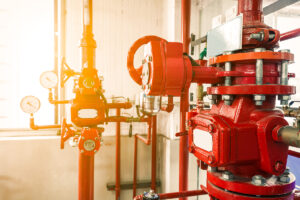
When it’s time to install your fire sprinkler system, pre-installation is a critical part of the process.
Fire sprinkler systems are the first line of defense when it comes to protecting property and lives in the event of a fire. Whether you’re installing a system in a new building or retrofitting an existing structure, understanding the installation process can help ease any concerns you may have and ensure that the project runs smoothly. An important part of this process is pre-installation, as it ensures the best results for your fire sprinkler system installation.
Why Pre-Installation?
While it would be nice if you could call up your local fire protection professionals and have a fire sprinkler system installed on the same day, that isn’t how this typically works. Fire sprinkler systems are complex, and they need to be carefully planned to ensure maximum coverage for your particular facility. That means there’s a good amount of pre-installation work that needs to take place before your fire sprinkler system can be installed. Without these steps, your system could prove to be ineffective, or it could even fail to meet minimum standard requirements put in place by the National Fire Protection Association (NFPA) and local fire codes.
Initial Consultation and Assessment
The first step in pre-installation is the initial consultation and assessment. During this phase, a fire protection company, like Fireline, will visit your property to evaluate the building’s specific needs. They’ll consider factors such as the type of occupancy, building layout, local fire codes, and any special requirements that might influence the system design.
A thorough assessment ensures that the fire sprinkler system is customized to provide optimal protection. This step also includes reviewing the building’s current infrastructure to identify any potential challenges, such as low water pressure or limited access points, that may need to be addressed during installation.
Design and Planning
Once the initial assessment is complete, the next step in pre-installation is designing the fire sprinkler system. This phase involves creating a detailed plan that outlines the layout of the sprinkler heads, piping, and control valves. The design must comply with national and local fire codes, such as standards set by the National Fire Protection Association (NFPA).
During the design phase, the fire protection company will also determine the most appropriate type of sprinkler system for your building. Common options include wet pipe systems, dry pipe systems, and pre-action systems, each suited to different environments and fire risks. Depending on the complexity of the project, the design process may take a few days to several weeks.
Permitting and Approvals
Before the installation can begin, the fire sprinkler system design must be submitted to the appropriate local authorities for approval. This step is critical to ensure that the system meets all safety standards and regulatory requirements. The permitting process can vary in length depending on your location and the specifics of the project.
It’s essential to work with a knowledgeable fire protection company that understands the local permitting process and can handle this step efficiently. Delays in permitting can push back the installation schedule, so early submission of plans is crucial.
Fire Protection Services from Fireline
Whether you need smoke detectors, fire extinguishers, or an automatic sprinkler system installed at your commercial property, Fireline has you covered. We have been protecting people and property from fire damage since 1947—and our experience shows in our excellent work! We are known for our superb customer service, our expertise, and our reliability. For more information on how we can help your residential or commercial property, visit us online or give us a call at (800) 553-3405. We are in Baltimore, MD, with a second office in Leesburg, VA. For more fire safety tips, be sure to follow us on Facebook, Twitter, and LinkedIn.
